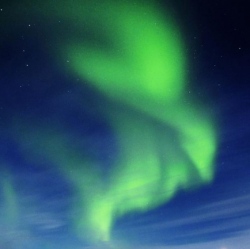
A new radio telescope array developed by a consortium led by Caltech can simultaneously image the entire sky at radio wavelengths with unmatched speed, helping astronomers to search for objects and phenomena that pulse, flicker, flare, or explode.
The Owens Valley Long Wavelength Array (OV-LWA) is already producing unprecedented videos of the radio sky. Astronomers hope that it will help them piece together a more complete picture of the early universe and learn about extrasolar space weather, the interaction between nearby stars and their orbiting planets.
The consortium includes astronomers from Caltech, JPL, Harvard University, the University of New Mexico, Virginia Tech, and the Naval Research Laboratory. “Our new telescope lets us see the entire sky all at once, and we can image everything instantaneously,” says Gregg Hallinan, an assistant professor of astronomy at Caltech and OV-LWA’s principal investigator.
Combining the observing power of more than 250 antennas spread out over a desert area equivalent to about 450 football fields, the OV-LWA is uniquely sensitive to faint variable radio signals such as those produced by pulsars, solar flares, and auroras on distant planets.
A single radio antenna would have to be 100 meters wide to achieve the same sensitivity (the giant radio telescope at Arecibo Observatory in Puerto Rico is 305 meters in diameter). However, a telescope’s field of view is governed by the size of its dish, and such an enormous instrument would only see a tiny fraction of the entire sky.
“Our technique delivers the best of both worlds, offering good sensitivity and an enormous field of view,” says Hallinan.
Operating at full speed, the new array produces 25 terabytes of data every day, making it one of the most data-intensive telescopes in the world. For comparative purposes, it would take more than 5,000 DVDs to store just one day’s worth of the array’s data.
It uses a supercomputer with graphics processing units similar to those used in modern computer games to combine signals from all of the antennas in real time. These combined signals are then sent to a second computer cluster, the All-Sky Transient Monitor (ASTM) at Caltech and JPL, which produces all-sky images in real-time.
Hallinan says that the OV-LWA holds great promise for cosmological studies and may allow astronomers to watch the early universe as it evolved over time. Scientists might then be able to learn how and when the universe’s first stars, galaxies, and black holes formed. But the formative period during which these events occurred is shrouded in a fog of hydrogen that is opaque to most radiation.
Even the most powerful optical and infrared telescopes cannot peer through that fog. By observing the sky at radio frequencies, however, astronomers may be able to detect weak radio signals from the time of the births of those first stars and galaxies.
